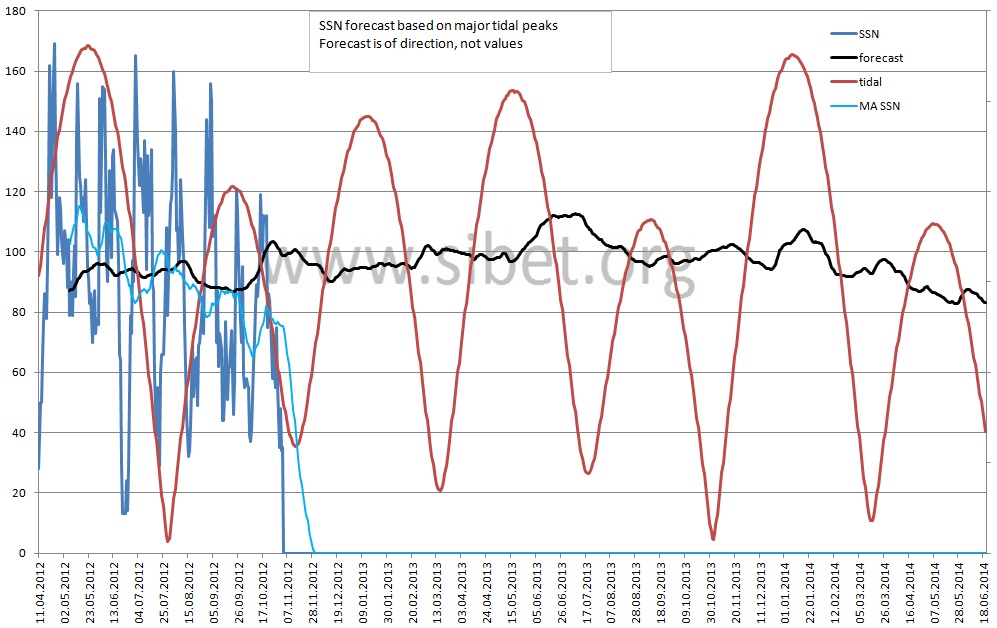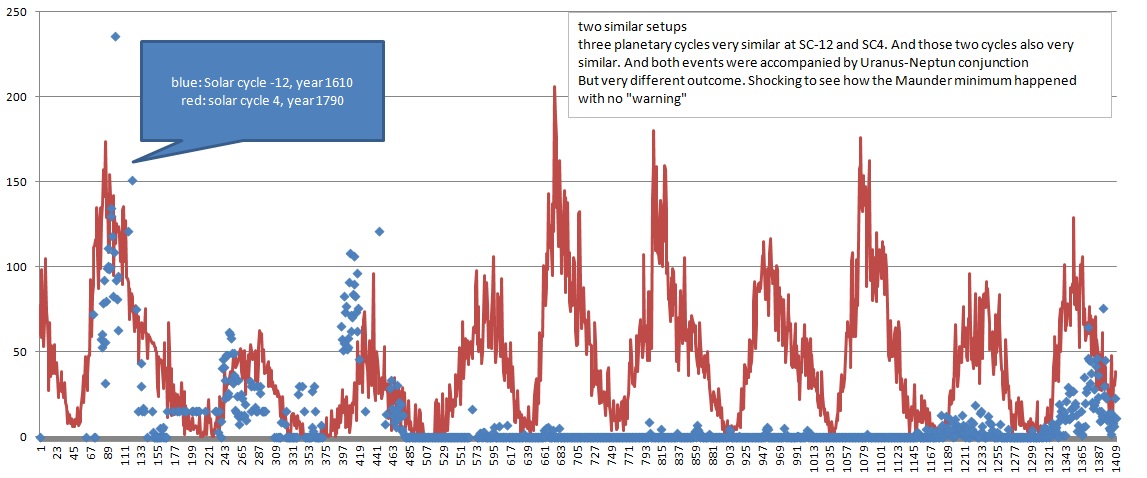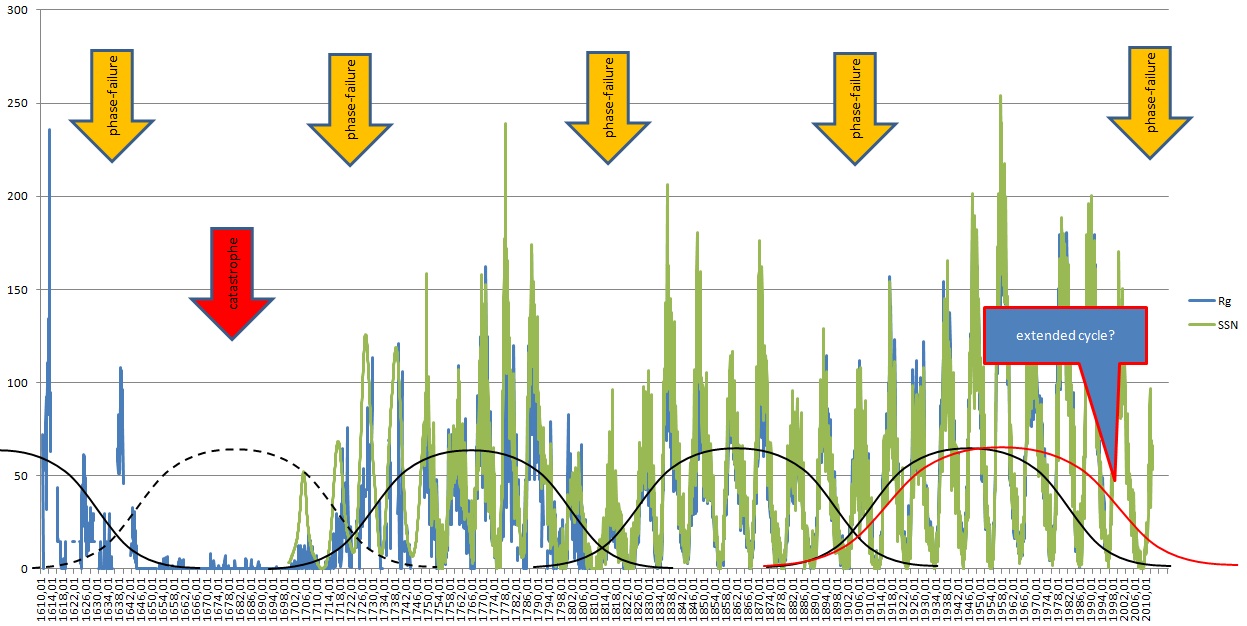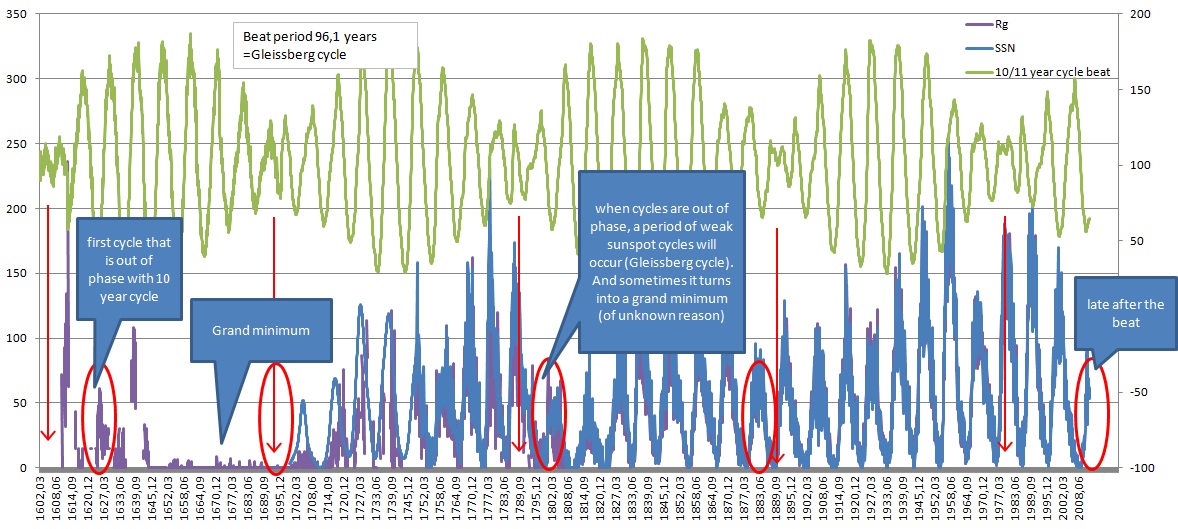bigbud
Level 3 Rank
  
Posts: 180
|
Post by bigbud on Oct 29, 2012 13:18:10 GMT
time is running out for SC24, but we are missing another surge
From the planetary cycles, time since minimum and the shape of the cycle, we have an indication of maximum in about 8-12 months.
There are two strong tidal peaks in the first half of 2013 that should produce the SC24-maximum, around summer/fall 2013.
An even stronger tidal peak in January 2014, but my data suggest that is too late for maximum. Some kind of lower top in SSN probably.
Estimate for next minimum is around summer 2019 or later
|
|
bigbud
Level 3 Rank
  
Posts: 180
|
Post by bigbud on Oct 29, 2012 14:16:52 GMT
a guess for the coming maximum:
elevated flux the first 6 months of 2013, with maximum around June-July 2013
Another spike around January 2014, but too shortlived to be the maximum.
As Leif pointed out, the southern hemisphere seem not to have topped. Guess that is where we get the surge first half of 2013, to complete topping in the south.
|
|
bigbud
Level 3 Rank
  
Posts: 180
|
Post by bigbud on Oct 31, 2012 15:43:16 GMT
|
|
bigbud
Level 3 Rank
  
Posts: 180
|
Post by bigbud on Nov 4, 2012 16:08:08 GMT
have added some charts and material on my page www.sibet.org/solar/index.htmlThink this is my best forecast of sunspot number, showing daily data. Suggesting a possible cycle maximum in June-July 2013. February 2014 should also be a peak. The 13month average should top somewhere in that interval. (The top so far in SSN should be too early for a sunspot-maximum)  |
|
bigbud
Level 3 Rank
  
Posts: 180
|
Post by bigbud on Nov 5, 2012 9:10:46 GMT
been looking at my scenarios for the monthly SSN, and discover that the 13-month smoothed SSN could have peaked allready. I do expect sunspot level to rise again in 2013, but it is not certain that we will make a higher top in 13MA.
-------------
My studies on tidal peaks from Venus+Earth+Jupiter shows a cross-correlation of 30-50 days. So highest sunspot activity around 40 days after the tidal peak.
Tidal peaks happen around Venus-Jupiter conjuntions/oppositions, every ~118 days.
Major peaks happen each 236 or 354 days
The rally major peaks happen each ~590 days
We have a big peak in May 2013, and a major peak in January 2014. They should keep solar activity elevated, but thereafter it should decline.
|
|
|
|
Post by Doug Huffman on Nov 5, 2012 11:41:56 GMT
Read Edward R. Tufte's The Visual Display of Quantitative Information. He coined the phrase "chart junk".
|
|
bigbud
Level 3 Rank
  
Posts: 180
|
Post by bigbud on Nov 8, 2012 13:09:45 GMT
the simple explanation of the solar cycle:
The ~11 year solar cycle "wants" to be in phase with the wobble, or Jupiter-Saturn cycle of 10 years. However the longer tidal cycles makes the cycles longer than 10 years, and this causes drifting out of phase.
Every ~95 years the 10 and 11 year cycles are out of phase, wich results in a phase-failure and weak sunspotcycle (typical 2 or 3 cycles)
But the phase-failure needs some other conditions (in the tidal cycles) to happen, so the phase-failures is not always 95 years apart.
Recent failures:
~1985 that didnt materialize before now (SC24 and SC25)
~1890 that materialized on-time in SC12+13 (and partial 14)
~1790 that materialized some later in SC5+6
~1690 that materialized on-time in SC-5 and SC-4 (and partial SC-3)
~1600 that materialized much later in SC-9 and SC-8
If the conditions in the other tidal cycle (the 12 year cycle) are "right", the phase-failure can happen near the optimal period. But if the configuration is not right, the failure will come some decades later.
What we see in the Maunder minium was two failures that happened very close in time - a double bottom (probably same condition at Spörer and Wolf minima)
Looking forward we have the next failure around year 2080, some 50 years after this current phase-failure. I have to do some work on estimating whether that phase-failure will happen then (making two narrow lows, but not as narrow as the Maunder) or whether the configuration is not right, pushing the phase failure some decades later...
An intitial look says we are on a "border", but probably should make the phase-failure on-time and around year 2075-2095
----------
notice that there is a supercycle here of ~170 years (caused by the 11 year and 12 year cycles)
And within one such supercycle there are typical two phase-failures (around 100 years apart)
Sometimes these failures come as a "pair" and cause a grand minima like Wolf, Spörer and Maunder. Or they are well-spaced like the 1790/1890.
Right now we have a pair of 1985/2080. The first one was delayed until now, while the second one should be on-time. But they should not be narrow enough to make a grand minima (rather two semi-minima)
----------
seems that the three cycles alone cant explain the deep Maunder minimum. The wobble (Jupiter-Saturn cycle) is a simplyfied version, and near Uranus-Neptun conjunctions this effect has to be added. This was the case at the Maunder.
|
|
bigbud
Level 3 Rank
  
Posts: 180
|
Post by bigbud on Nov 9, 2012 13:34:59 GMT
hmm, the Maunder minimum is a puzzle
Studying the available data, I can identify the cycles as expected from the planetary cycles.
However the cycles -9 to -5 are abnormally weak, practically turned off
And cannot be explained from planetary cycles the way I see them
If it were just a couple cycles it would be understandable, but not with 5 cycles in a row...
Some other force is causing this turn-off...
|
|
bigbud
Level 3 Rank
  
Posts: 180
|
Post by bigbud on Nov 9, 2012 22:40:02 GMT
comparing, monthly data what I am finding here, is that we had a "phase-failure" around SC-11 (year ~1620, not 1640 as stated above). And the next failure around year 1700 Similar we had phase-failure at Dalton and the 1900-minimum The difference is that "someone" pushed the off-button in years 1650-1700 and between the two phase-failures. Perhaps the cycles were there, just with invisible spots? From the planetary cycles I would have expected fairly strong solar cycles in the years 1650-1690, but instead there was some kind of "catastrophe" that killed the sunspot activity. And it didnt wake up until after the next phase-failure. So the first "startup" in 1650 failed, and the Sun had to wait until the next chance around 1700? From stockmarket terminology I could say that the Dalton-low was a bottom, and the rally began thereafter. But the year 1625-45 bottom was only a dead cat bounce, and then the crash followed...  |
|
bigbud
Level 3 Rank
  
Posts: 180
|
Post by bigbud on Nov 9, 2012 23:53:26 GMT
a hypothesis comes up...
the three planetary cycles explain the individual sunspot cycles, and two supercycles of ~170 and ~95 years
most 170 year cycles have two phase-failures (95 year cycle), but some probably only has one
The normal 170 year cycle has a pair of minima/phase-failures, and they can be separate like the Dalton/1900-minimum, or there can be a catastrophe that produces a grand minimum like the Maunder.
Those 170 year cycles with only one minima have probably no grand minimum-potential
There is probably a bigger supercycle of ~850-1020 years
So what causes the catastrophe, and are there any warning signs?
Current SC24 is in a phase-failure. When looking at the two past supercycles we should maybe look for two weak cycles SC24/25 like SC-11/-10 and SC5/6.
And then we may "rally" like SC7 or "crash" like Maunder...
|
|
|
|
Post by sigurdur on Nov 10, 2012 3:37:08 GMT
Keep up the good work bigbud. Very interesting observations and insight.
|
|
bigbud
Level 3 Rank
  
Posts: 180
|
Post by bigbud on Nov 10, 2012 12:11:03 GMT
part of my hypothesis would look like this: At the Maunder minimum there were two sunspotcycles after the phase-failure, "feeding" on the old cycle (black ~100 year cycle). However the next black cycle failed due to some catastrophe. Current situation is somewhat unclear. We are at a phase-failure in SC24, and it is happening a bit later than the cycle projection. So could be that the cycle is extended. We are still feeding on the old cycle, and don´t know whether we get a catastrophe in the next one...  |
|
bigbud
Level 3 Rank
  
Posts: 180
|
Post by bigbud on Nov 10, 2012 20:23:22 GMT
a bit more detail - please forgive my chart junk  SC24 is out of phase with 10 year cycle, and it happens quite late after the Gleissberg-beat. Is that good or bad? (grand minimum potential or not?)  |
|
|
|
Post by karlox on Nov 11, 2012 9:48:50 GMT
BigBud, What do you mean by "catastrophe", please? Some Internal Sun unknown cycle or crossed modulation among different length-cycles? You seem to be doing a lot of work BigBud, could you have most expert Leif I. to check it? Sounds very interesting and very difficult since even in short term NASA´s forecast for this cycle (the one mankind is best prepared to watch our sun) the show continous corrections on both expected max period, cycle total lenght and amplitude... somewhat like weather forecast... don´t you think?
Hope to visit Norway to watch nice auroras sometime in the next two years!
Best regards
|
|
bigbud
Level 3 Rank
  
Posts: 180
|
Post by bigbud on Nov 11, 2012 10:35:42 GMT
BigBud, What do you mean by "catastrophe", please? Some Internal Sun unknown cycle or crossed modulation among different length-cycles? You seem to be doing a lot of work BigBud, could you have most expert Leif I. to check it? Sounds very interesting and very difficult since even in short term NASA´s forecast for this cycle (the one mankind is best prepared to watch our sun) the show continous corrections on both expected max period, cycle total lenght and amplitude... somewhat like weather forecast... don´t you think? Hope to visit Norway to watch nice auroras sometime in the next two years! Best regards Hi karlox I find a comment in this report very interesting arxiv.org/ftp/physics/papers/0703/0703187.pdf"We can therefore speculate that a grand minimum in solar activity possibly occurs when the solar dynamo is set up for a secular maximum (decreasing speed of the surface circulation, increasing speed of the deep circulation, lowering of the reversal depth), but for some reason the surface circulation slows down too much, and the deep return branch of the meridional circulation lands in layers with diffusivity below a certain threshold." -I dont know if I understand or agree on their work, but I tend to agree on this statement. The three planetary cycles of ~10, 11 and 12 years suggested a weak period just after year 1600 (Gleissberg low). But they were suggesting a stronger period in the years 1640-1690, that obviously failed (catastrophe, or kind of cycle inversion?) So some mechanism caused an anomaly in the soalr activity, that lasted until the next Gleissberg-low, where the Sun managed to switch back to normal activity. The three planetary cycles are simplyfied. Specially the 10 year cycle that I think is linked to solar wobble, or barycentre movement (relative to Solar center). And here Uranus+Neptun have a significant effect around Uranus+Neptun conjunctions. So a possible explaination is that the (change in) solar wobble got so weak at the Gleissberg-low (because of Uranus+Neptun conjunction) that "the solar dynamo" (or some mechanism in the Sun) fell into a different state, and stayed there into the next Gleissberg low, where it switched back. |
|